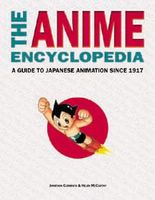
 The Anime Encyclopedia
The Anime Encyclopedia, that massive guide that arrived in 2001, is now getting a second edition for later this year! With updated information and added reviews (just think of all that anime from the last FIVE years),
The Anime Encyclopedia 2 is working its way through the editorial process, but here is a sneak piece at a new review, which is the newly Oscar-nominated
Howl's Moving Castle:
HOWL'S MOVING CASTLE
- Eng. Release?: YES; (2004);
- Jpn: Howl no Ugoku Shiro
- Aka NONE
- Movie.
- Director/s: Hayao Miyazaki
- Screenwriter/s: Hayao Miyazaki
- Designer/s: Hayao Miyazaki
- Animator/s: Akihiro Yamashita, Takeshi Inamura, Kitaro Kosaka
- Music: Joe Hisaishi
- Prd: Studio Ghibli, Gonzo, T2, Production I.G., Madhouse
- Dur: 119 mins
Plain, shy hat-maker Sophie is cursed by the Witch of the Waste to turn prematurely into an old woman. In search of a remedy, she works as a cleaner for Howl, a handsome wizard who, it is rumored, steals the hearts of young girls. Sophie brings a woman's touch to a ramshackle bachelor household, edging her way into the antagonistic world of Howl, his boy apprentice Markl, and Calcifer, the fire demon, whom Howl has bound to the castle's machinery to keep the power flowing. Meanwhile, Howl and several of his pseudonyms are resisting a king's order to fight against the wizards of a rival state. He contends with two women with whom he seems to have a past, the Wicked Witch, whose fading spells cause her to age and collapse into dementia, and Madame Suliman, a government sorcerer who urges Howl to enter royal service.
Hayao Miyazaki's adaptation of the novel by Diana Wynne Jones adds several personal touches, starting with a wheezing comic-relief lapdog. The wholly magical realm of the original novel is given a more modern, steam-based technology, and a new subplot about a distant war, fraught with mixed feelings that appear rooted in Japan's role as bystander and beneficiary to the invasion of Iraq. War breaks out over the search for an important artefact - the infamous real-world "weapons of mass destruction" transformed here into a missing prince, demands for whose return lead to the background conflict.
HMC wrestles with the ideas of duty and obligation, and how best to do the right thing in a world gone wrong.
Flushed with international approbation for
Spirited Away and Miyazaki's long-deserved Academy Award,
HMC was less a movie than a national celebration. On its opening weekend 1.1 million Japanese spent over $14 million -- an opening surpassed only by
Harry Potter and the Sorcerer's Stone (2001). Buena Vista invested reverently in the English language adaptation, casting the new
Batman Christian Bale, as the selfish Howl, and Billy Crystal in a comic turn as Calcifer. The dub is also tied firmly into America's film heritage with Jean Simmons as the aged Sophie, and Lauren Bacall as the Witch of the Waste.
HMC is a charming film, visually inventive and magnificently crafted. The castle itself is a fabulous creation, like a magic mechanical version of Baba Yaga's Hut from Russian folklore, and the settings are beautifully realized, with the wild mountains and uplands handled particularly well. However, there is a difference between an excellent film and an excellent Miyazaki film. All film
is a collaborative process, but in the best films of a genius one finds a unique creative soul, a way of seeing and showing that can be imitated, but not replicated. Other great Japanese directors, given Ghibli's unrivalled resources, could have made a movie very like
HMC; but no one else could have made anything approaching
Nausicaa.
HMC was originally intended for another director until Miyazaki stepped in, the legendary perfectionist seemingly unable to let a good idea go to waste, even though he had supposedly retired. The film's hidden message is Miyazaki's love letter to Akemi Ota, the young, hard-working animator girl he married so long ago, a plucky heroine who woke up one day to find herself a glorified scullery maid to a self-absorbed creative, obsessed with distant battles and otherworldly sorceries.
HMC sometimes appears more like the product of a committee rehashing Miyazaki's glory days, heroines confronted by outsized obstacles, contending witches and lead characters unwittingly transformed. This problem may lie in the incorporation of the ideas of other, younger colleagues into what has always been a unique and sometimes an autocratic vision. Similarly, absolute simplicity and innocence are hard to handle realistically - in
My Neighbor Totoro they work sublime wonders, but in
HMC it leaves the characters alienated from the events around them, like preoccupied children or the "little people" of
Patlabor, ignorant of a big picture that is only apparent on repeat viewing.
It may be a tribute to the original novel character, who fed on the souls of besotted young girls, that Howl is Miyazaki's first consciously beautiful male hero, who gets to have Miyazaki's first full-on screen kiss, but he's also the first Miyazaki hero to turn into a conventional father-figure by the end of the movie. By the close of the film, the wild, magical creatures are tamed into an image of a nuclear family. The magnificently depraved Witch is a gentle granny mumbling in a sunny garden, the resourceful Markl a kid teasing an old dog, and the fire elemental a loveably grouchy Disney domestic appliance, as the irresistible wizard steers his companion and the domesticated castle into the happy-ever-after. Compare this with the ending of
Princess Mononoke, where San and Ashitaka agree to accept each other's separate needs without compromising their love.
The major Miyazaki themes are still there - integrity, consideration for others, the destructive power of war and greed, ecological awareness, and the synergy of true teamwork. What is lacking is a spark so unique it seems churlish to expect Miyazaki to produce it, on demand, movie after movie; and the supernaturally sure-footed sense of pace and timing that inform his greatest works.
HMC is a detailed and generous answer, but so caught up in its own complexity that it seems to have misheard the question.


























